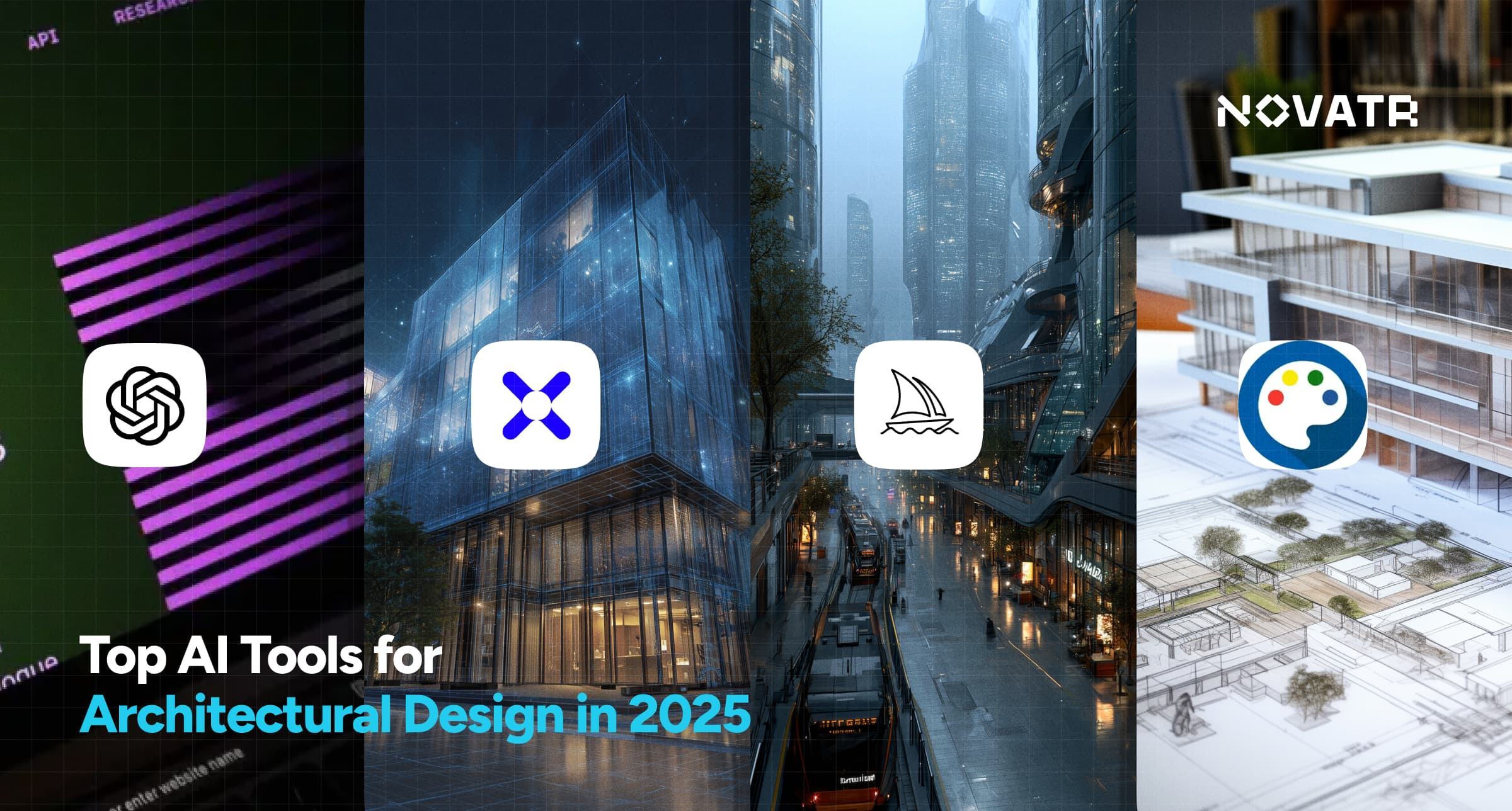
The times when artificial intelligence (AI) in architecture was a distant concept of the future are long gone, and what is available now is the present. Such a disruptive technology is sweeping a change in the way architectural designers plan, visualize, and manage a project from its initial stage to the implementation. According to the Royal Institute of British Architects, in 2025, more than 41 percent of architectural firms had adopted some form of AI into their operations. Additionally, McKinsey & Company highlighted that architecture design and construction are among the top five industries expected to see a 60–70% increase in productivity through AI adoption by 2030.
In the U.S., statistics from Data.gov and the Bureau of Labor Statistics (BLS) show rising investments in smart cities and digital infrastructure, with architecture design software seeing an annual growth rate of over 16.2% CAGR, forecasted to hit $4.1 billion by 2030. AI for architectural design now supports not only aesthetics and functionality but also energy modeling, sustainable architecture design, and automation of repetitive design tasks. From streamlining the architectural design process to enabling more responsive client experiences, AI continues to alter the DNA of the architecture industry.
How Is AI Being Used in the Architecture Industry Today?
AI plays a pivotal role across all phases of architectural design, from early ideation to final construction documentation.
Here’s how:
-
Site planning is still an automated process by using generative design tools like Maket.ai and Finch 3D, which consider factors like zoning, lighting, wind orientation, and budget. This enables the architectural designers to come up with several layouts in a few minutes.
-
Integration of BIM enables systems such as Autodesk Forma and BricsCAD BIM as tools to improve the conventional processes. These tools offer live data integration, the automation of clash detection, and simplified documentation of the permit submittals.
-
AI-driven rendering engines (e.g., Adobe Firefly or Arko.ai) can be used to create a photorealistic view of a sketch or written description and enhance the communication between the client and the designer, and the approval of a concept.
-
Automation programming has helped in scheduling the design, checking the code, and optimization of space, thus helping architectural design firms to concentrate more on creativity.
-
Machine learning and smart analytics models forecast building performance on the basis of climate, usage, as well as materials, and thus, the modern architecture design becomes more cost-effective.
What Are the Benefits of Using AI in Architectural Design?
1. Faster project delivery
Progress under the generative design and automation reduces the project timeframes that previously required weeks and nowadays only hours, particularly in the conceptual development phases. The users of Finch 3D, for instance, cite up to a 60% reduction in the time spent on development at the early stages.
2. Better accuracy
Artificial intelligence will eliminate the manual error in the measurement, cost estimation, and code compliance in urban or adaptive reuse projects.
3. Enhanced creative scope
Architecture design skills powered by AI generate multiple alternatives, offering architectural designers broader choices for modern, experimental, or sustainable architecture design projects.
4. Sustainability modeling
Tools like Autodesk Forma provide real-time feedback on daylight penetration, energy usage, and emissions, enabling architectural designs that align with green building standards.
5. Client personalization
AI tailors design outputs to client preferences using data from previous projects or user behavior, turning architecture design into a more customer-centric process.
6. Minimal operation costs
Automation will result in cost-effective documentation, modelling, and changes, particularly when large-scale developments are involved.
Which AI Tools and Platforms Are Popular Among Architects?

Generative Design and Planning
1. Maket.ai
Enables quick floor plans from written prompts. It’s a go-to for early-stage planning, rapidly translating client briefs into viable layouts.
2. Architectures
Utilizes real-time parametric design exploration based on regulations, sun path, and material constraints.
3. Finch 3D
Perfect for zoning-based design iterations. It adjusts layouts dynamically as parameters change, ideal for architectural designers working on complex, mixed-use developments.
Visual Design and Rendering
1. Adobe Firefly
Creates textures, moodboards, and concept art using simple prompts. A favorite for visual storytelling in architectural presentations.
2. Arko.ai
Transforms 2D sketches into full-color renderings and animations. Seamlessly integrates with architecture software suites.
3. Visoid
Delivers VR-compatible photorealistic renders, enabling clients to “walk through” architectural designs.
4. VEED AI Image Generator
This AI image generator creates abstract renderings and design narratives based on text prompts. Great for presenting ideas to clients or enriching architectural storyboards.
Other AI Tools
1. BricsCAD BIM
Offers intelligent drafting, automatic detailing, and construction-ready outputs.
2. Autodesk Forma
A top architecture design software solution for sustainability assessments and urban planning.
3. Hypar
Modular approach to design supports custom AI workflows for parametric, multi-unit, or institutional projects.
4. Part 3 Submittal Assistant
Auto-generates detailed permit documents with compliance checks, ideal for firms offering architectural design services.
What Are the Limitations and Ethical Concerns Around AI in Architecture?
While AI has brought profound advancements, it is not without flaws or ethical dilemmas:
1. Design bias
AI tools are only as good as their training data. If not carefully curated, designs may reflect biases in form, function, or culture.
2. Overreliance
An architectural design company can risk sidelining human creativity by relying too heavily on automation, which may limit exploration of architecture design principles.
3. Job displacement
Concerns persist that automation could marginalize roles in drafting, model detailing, and some architectural designer jobs, especially for entry-level professionals.
4. Intellectual property issues
Who owns AI-generated designs? Firms must clarify usage rights, especially when outsourcing or collaborating using AI platforms.
5. Lack of transparency
Many tools don’t explain how they arrive at certain results, challenging accountability.
6. Client misrepresentation
Mislabeling AI-generated visuals as hand-crafted can mislead clients, contradicting ethics in architectural design services.
A healthy balance between AI support and professional oversight is essential to mitigate these issues.
What Skills Do Architects Need to Work with AI Tools?

To stay competitive, architectural designers must adapt and upskill. Critical areas include:
1. Technical Skills of an Architecture Designer:
- Proficiency in advanced architecture design software like Revit, Rhino, or BricsCAD BIM, which is very effective in modern architecture design.
- Ability to manipulate AI design inputs, e.g., writing prompts, tagging metadata, using APIs.
- Competence in data interpretation, energy modeling, and automation workflows.
2. Soft Skills of an Architect Designer:
- Design judgment: Not all AI outputs are viable strong fundamentals in architecture design concept, and architecture design principles are essential.
- Ethics and communication: Explaining AI processes to clients, city officials, or collaborators is increasingly vital.
- Collaboration: Cross-disciplinary teams involving AI specialists require excellent teamwork and leadership.
3. Professional Development:
- A certificate in architectural design with a focus on digital tools or AI integration boosts employability.
- Familiarity with architecture design skills and how to navigate the architectural design process makes an architect AI-ready.
Understanding architectural designer job requirements is essential to remain competitive in today’s tech-driven market.
Conclusion
AI for architectural design in 2025 offers remarkable promise, but it’s not a silver bullet. Used wisely, AI enhances creativity, boosts efficiency, and supports sustainability. Platforms like Maket.ai, Finch 3D, Adobe Firefly, and Autodesk Forma showcase what’s possible when humans and machines co-create.
Still, challenges remain. Understanding “what does an architectural designer do?” is evolving, and only those who blend digital fluency with creative intuition will thrive.
Explore the Building Information Modeling Course for Architects by Novatr and join the next wave of sustainable designers reshaping our world.
Visit our resource page to get started and explore expert guidance on advancing your career.
Was this content helpful to you



.jpg)





.png)

